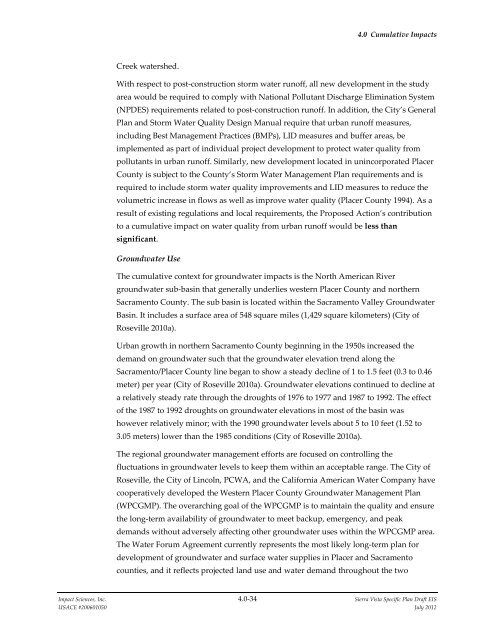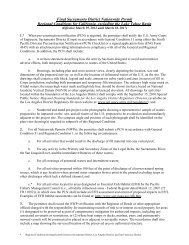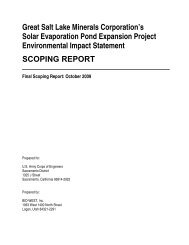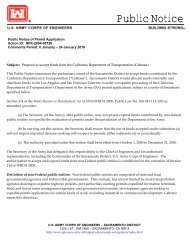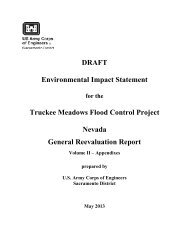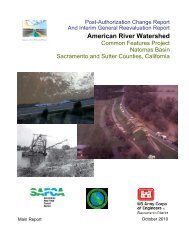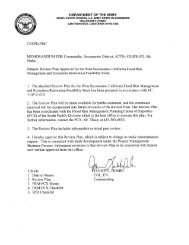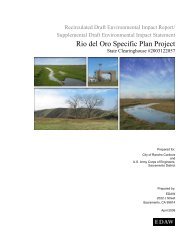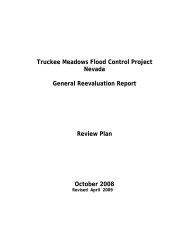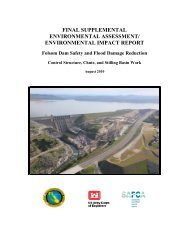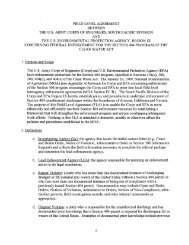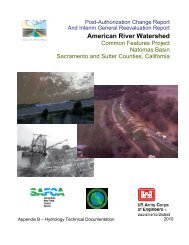4.0 CUMULATIVE IMPACTS - Sacramento District - U.S. Army
4.0 CUMULATIVE IMPACTS - Sacramento District - U.S. Army
4.0 CUMULATIVE IMPACTS - Sacramento District - U.S. Army
You also want an ePaper? Increase the reach of your titles
YUMPU automatically turns print PDFs into web optimized ePapers that Google loves.
<strong>4.0</strong> Cumulative Impacts<br />
Creek watershed.<br />
With respect to post-construction storm water runoff, all new development in the study<br />
area would be required to comply with National Pollutant Discharge Elimination System<br />
(NPDES) requirements related to post-construction runoff. In addition, the City’s General<br />
Plan and Storm Water Quality Design Manual require that urban runoff measures,<br />
including Best Management Practices (BMPs), LID measures and buffer areas, be<br />
implemented as part of individual project development to protect water quality from<br />
pollutants in urban runoff. Similarly, new development located in unincorporated Placer<br />
County is subject to the County’s Storm Water Management Plan requirements and is<br />
required to include storm water quality improvements and LID measures to reduce the<br />
volumetric increase in flows as well as improve water quality (Placer County 1994). As a<br />
result of existing regulations and local requirements, the Proposed Action’s contribution<br />
to a cumulative impact on water quality from urban runoff would be less than<br />
significant.<br />
Groundwater Use<br />
The cumulative context for groundwater impacts is the North American River<br />
groundwater sub-basin that generally underlies western Placer County and northern<br />
<strong>Sacramento</strong> County. The sub basin is located within the <strong>Sacramento</strong> Valley Groundwater<br />
Basin. It includes a surface area of 548 square miles (1,429 square kilometers) (City of<br />
Roseville 2010a).<br />
Urban growth in northern <strong>Sacramento</strong> County beginning in the 1950s increased the<br />
demand on groundwater such that the groundwater elevation trend along the<br />
<strong>Sacramento</strong>/Placer County line began to show a steady decline of 1 to 1.5 feet (0.3 to 0.46<br />
meter) per year (City of Roseville 2010a). Groundwater elevations continued to decline at<br />
a relatively steady rate through the droughts of 1976 to 1977 and 1987 to 1992. The effect<br />
of the 1987 to 1992 droughts on groundwater elevations in most of the basin was<br />
however relatively minor; with the 1990 groundwater levels about 5 to 10 feet (1.52 to<br />
3.05 meters) lower than the 1985 conditions (City of Roseville 2010a).<br />
The regional groundwater management efforts are focused on controlling the<br />
fluctuations in groundwater levels to keep them within an acceptable range. The City of<br />
Roseville, the City of Lincoln, PCWA, and the California American Water Company have<br />
cooperatively developed the Western Placer County Groundwater Management Plan<br />
(WPCGMP). The overarching goal of the WPCGMP is to maintain the quality and ensure<br />
the long-term availability of groundwater to meet backup, emergency, and peak<br />
demands without adversely affecting other groundwater uses within the WPCGMP area.<br />
The Water Forum Agreement currently represents the most likely long-term plan for<br />
development of groundwater and surface water supplies in Placer and <strong>Sacramento</strong><br />
counties, and it reflects projected land use and water demand throughout the two<br />
Impact Sciences, Inc. <strong>4.0</strong>-34 Sierra Vista Specific Plan Draft EIS<br />
USACE #200601050 July 2012


